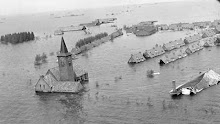Life list now 184 species
>>South through the Red Sea, 6-8 Mar 1946
These three days was magical for me as we were entering tropical waters. At night, I was fascinated by the glowing, fluorescent wake. We saw flying fish. The air was warm and the sun was bright. And the birds were mostly new and sometimes exotic looking, quite different from those in the Mediterranean.
I also learned a bit about life from the song repeated frequently in an American accent on the ship’s public address system: One Meatball. Perhaps the record was a left over from the ship’s former glory days as a liner in the pre-war Great Depression. I don’t remember all the words, but these became engraved in my mind:
The little man felt ill at ease,
Said “Some bread. son, if you please”
The waiter’s voice rang through the hall
“There ain’t no bread with ONE meatball!”
Said “Some bread. son, if you please”
The waiter’s voice rang through the hall
“There ain’t no bread with ONE meatball!”
I could not imagine this song being written in England. It seemed to typify the cold-hearted side of American capitalism, contrasting with the welfare state I had known in Britain. This had indeed treated me well, providing free schooling up to university and now a cruise!
>>>
“Among the gulls following the boat [from Suez on 6 March] was one bird I was unable to identify but which I now know was the Brown Booby* (Sula l. lecogaster). On 8 March, nearing the southern end of the Red Sea, two more of these appeared in the morning and, from 1700 to 1800, there were many as we passed within about three miles of the “Seven Sisters” islands. They were flying towards the islands (presumably for roosting) in parties of up to 11. With them were smaller numbers (about 10%) of Masked Boobies* (Sula cyanops [dactylatra]).
View Larger Map
A ‘stranger’ appeared at 1645 on 6 March. The range (c 300 yds) was too great for much detail but I saw it was apparently completely white, rather resembling an albino kestrel. The tail was very long, the wings somewhat like those of a gull. It flew very low over the water, sometimes hidden by a wave. This was later identified as a Red-billed Tropicbird* (Phaethon aethereus).
A little later on 6 March, two more unknown species turned up briefly and at a distance. The first seems to have been the Sooty Gull* (Larus hempruchii), so common at Aden. The other resembled a small (half sized) edition of it and remains unidentified. On 8 March there were several Sooty Gulls as well as Lesser Black-backed Gulls and Yellow-legged Gulls.
A Caspian Tern* (Sterna caspia) overtook the ship about 0830 on 8 March. At a about the same time, a Squacco Heron* (Ardeola ralloides) came up from the stern and, after circling for a time, made off towards the east. In flight the following details were noted: size about as Buff-backed Heron, white (or white tinged slightly with buff) wings, tail and flanks; brown back, belly, abdomen, breast, neck and head; apparently greenish-yellow legs (trailing at c 30° to horl.), similarly coloured bill, noticeably striated on breast and head (and flanks?).
A couple of large unidentified hawks flew with long glides and infrequent flaps in a northerly direction at 1130. A bit later a possible Pallid Harrier (Circus macrourus) flew very low with typical harrier flight. It seemed all white with dark wing tips.
At about 1030 on the first day a White Wagtail came up from the stern and landed on board. I noticed it with another about 1330 and saw them occasionally during the next two days. The only other land bird seen was a Hoopoe that joined the ship on 8 March. It was first seen at 0915 and several times later when it would fly from one precarious perch on an external porthole to another.”


No comments:
Post a Comment